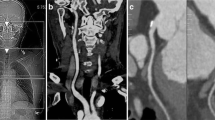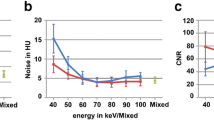Abstract
The purpose of this work was to compare the diagnostic performance of a single-contrast or a double-contrast dose of carotid contrast-enhanced MR angiography (MRA). One-hundred nineteen patients (mean age 65±14.4 years) underwent carotid contrast-enhanced MRA with a standardized protocol (repetition time/echo 3.73 ms/1.38 ms, flip-angle 25°, acquisition-time 19 s, voxel size 1.2×1.2×0.9 mm3) on a 1.5-T scanner (Sonata, Siemens-Medical-Systems) using a neck phased-array coil. Contrast agent was administered intravenously at a rate of 3.0 ml/s, either as a single dose (n=57; 0.1 mmol/kg body weight) or as a double dose (n=62; 0.2 mmol/kg body weight) of meglumine gadoterate (0.5 M/l), followed by 30 ml saline. Qualitative image analysis was performed on maximum intensity projections using a five-point scale. Signal intensities were measured at three different vascular levels on both sides to assess the contrast-to-noise ratios (CNRs). Image quality was rated as good or excellent in all cases. A double dose did not influence the efficacy of carotid enhancement (CNR single dose 69.12±19.8; CNR double dose 70.01±20.7; p=0.81) compared with a single dose. In both dose groups the mean CNRs were inversely related to bodyweight, despite adjusted contrast volumes (p=0.0005). Double-dose contrast-enhanced carotid MRA is not superior to single-dose MRA, as overall diagnostic performance and quantitative contrast enhancement are equal. Being more cost-efficient, a single-dose administration of contrast agent is recommended for MRA of the carotid arteries.




Similar content being viewed by others
References
Sundgren PC, Sunden P, Lindgren A, Lanke J, Holtas S, Larsson EM (2002) Carotid artery stenosis: contrast-enhanced MR angiography with two different scan times compared with digital subtraction angiography. Neuroradiology 44:592–599
Nederkoorn PJ, Mali WP, van der Graaf Y (2002) Preoperative diagnosis of carotid artery stenosis: accuracy of non-invasive testing. Stroke 33:2003–2008
Remonda L, Senn P, Barth A, Arnold M, Lövblad K-O, Schroth G (2002) Contrast-enhanced 3D MR angiography of the carotid artery: comparison with conventional digital subtraction angiography. Am J Neuroradiol 23:213–219
Herold T, Paetzel C, Volk M, Bachthaler M, Zorger N, Feuerbach S, Strotzer M, Lenhart M (2004) Contrast-enhanced magnetic resonance angiography of the carotid arteries: influence of injection rates and volumes on arterial-venous transit time. Invest Radiol 39(2):65–72
Legget RW, Williams LR (1995) A proposed blood circulation model for reference man. Health Phys 69:187–201
Kim JK, Farb RI, Wright GA (1998) Test bolus examination in the carotid artery at dynamic gadolinium-enhanced MR angiography. Radiology 206:283–289
Volk M, Strotzer M, Lenhart M, Seitz J, Manke C, Feuerbach S, Link J (2001) Renal time-resolved MR angiography: quantitative comparison of gadobenate dimeglumine and gadopentetate dimeglumine with different doses. Radiology 220:484–488
Thurnher SA, Capelastegui A, Del Olmo FH, Dondelinger RF, Gervas C, Jassoy AG, Keto P et al (2001) Safety and effectiveness of single- versus triple-dose gadodiamide injection enhanced MR angiography of the abdomen: a phase III double-blind multicenter study. Radiology 219:137–146
Bluemke DA, Stillman AE, Bis KG, Grist TM, Baum RA, D’Agostino R, Malden ES, Pierro JA, Yucel EK (2001) Carotid MR angiography phase II study of safety and efficacy for MS325. Radiology 218:114–122
Boos M, Scheffler K, Haselhorst R, Reese E, Frohlich J, Bongartz GM (2001) Arterial first pass gadolinium-CM dynamics as a function of several intravenous saline flush and Gd volumes. J Magn Reson Imaging 13(4):568–576
Maki JH, Prince MR, Londy FJ, Chenevert TL (1996) The effects of time varying intravascular signal intensity and k-space acquisition order on three-dimensional MR angiography image quality. J Magn Reson Imaging 6:642–651
Hany TF, Schmidt M, Hilfiker PR, Steiner P, Bachmann U, Debatin JF (1998) Optimization of contrast dosage for gadolinium-enhanced 3D MRA of the pulmonary and renal arteries. Magn Reson Imaging 16(8):901–906
Takahashi S, Murakami T, Takamura M, Kim T, Hori M, Narumi Y, Nakamura H (2004) Is half-dose contrast-enhanced three-dimensional MR angiography sufficient for the abdominal aorta and pelvis? J Magn Reson Imaging 19(2):194–201
Laissy JP, Menegazzo D, Debray MP, Chillon S, Karila-Cohen P, Daikha A, Schouman-Claeys E (2001) Effect of contrast dilution on contrast-enhanced MR angiography of the aorta and renal arteries. Eur Radiol 11(7):1198–1205
Mitsuzaki K, Yamashita Y, Ogata I, Tang Y, Namimoto T, Takahashi M (1999) Optimal protocol for injection of contrast material at MR angiography: study of healthy volunteers. Radiology 213(3):913–918
Carroll TJ, Korosec FR, Petermann GM, Grist TM, Turski PA (2001) Carotid bifurcation: evaluation of time-resolved three-dimensional contrast-enhanced MR angiography. Radiology 220:525–532
Randoux B, Marro B, Koskas F, Duyme M, Sahel M, Zouaoui A, Marsault C (2001) Carotid artery stenosis: prospective comparison of CT, three-dimensional gadolinium-enhanced MR, and conventional angiography. Radiology 220(1):179–185
Oberholzer K, Kreitner KF, Kalden P, Pitton M, Requardt M, Thelen M (2001) Contrast-enhanced three-dimensional MR angiography of the carotid artery at 1.0 Tesla compared to i.a. DSA: is the method suitable for the diagnosis of carotid stenosis? RöFo 173(4):350–355
Lenhart M, Framme N, Volk M, Strotzer M, Manke C, Nitz WR, Finkenzeller T et al (2002) Time-resolved contrast-enhanced magnetic resonance angiography of the carotid arteries: diagnostic accuracy and inter-observer variability compared with selective catheter angiography. Invest Radiol 37(10):535–541
Cosottini M, Calabrese R, Puglioli M, Zampa V, Micehlassi C, Ortori S, Murri L, Bartolozzi C (2003) Contrast-enhanced three-dimensional MR angiography of neck vessels: does dephasing effect alter diagnostic accuracy? Eur Radiol 13(3):571–581
Ersoy H, Watts R, Sanelli P, Zimmerman RD, Kent KC, Bush HL, Prince MR (2003) Atherosclerotic disease distribution in carotid and vertebrobasilar arteries: clinical experience in 100 patients undergoing fluoro-triggered 3D Gd-MRA. J Magn Reson Imaging 17(5):545–558
Goyen M, Herborn CU, Vogt FM, Kroger K, Verhagen R, Yang F, Bosk S, Debatin JF, Ruehm SG (2003) Using a 1 M Gd-chelate (gadobutrol) for total-body three-dimensional MR angiography: preliminary experience. J Magn Reson Imaging 17(5):565–571
Hendrick RE, Haacke EM (1993) Basic physics of MR contrast agents and maximization of image contrast. J Magn Reson Imaging 3:137–148
North American Symptomatic Carotid Endarterectomy Trial Collaborators (1991) Beneficial effect of carotid endarterectomy in symptomatic patients with high-grade carotid stenosis. N Engl J Med 325:334–453
Meaney JFM (2003) Magnetic resonance angiography of the peripheral arteries: current status. Eur Radiol 13:836–852
Fink C, Bock M, Kiessling F, Lichy MP, Krissak R, Zuna I, Schmahl A, Delorme S, Kauczor HU (2004) Time-resolved contrast-enhanced three-dimensional pulmonary MR-angiography: 1.0 M gadobutrol vs. 0.5 M gadopentetate dimeglumine. J Magn Reson Imaging 19(2):202–208
Willig DS, Turski PA, Frayne R, Graves VB, Korosec FR, Swan JS, Mistretta CA, Grist TM (1998) Contrast-enhanced 3D MR DSA of the carotid artery bifurcation: prelimary study of comparison with 2D and 3D time-of-flight MR angiography. Radiology 208:447–451
Kopka L, Vosshenrich R, Rodenwaldt J, Grabbe E (1998) Differences in injection rates on contrast-enhanced breath-hold three-dimensional MR angiography. Am J Roentgenol 170:345–348
Kallmes DF, Omary RA, Dix JE, Evans AJ, Hillman BJ (1996) Specificity of MR angiography as a confirmatory test of carotd artery stenosis. Am J Neuroradiol 17:1501–1506
Roos JE, Desbiolles LM, Weishaupt D, Wildermuth S, Hilfiker PR, Marincek B, Boehm T (2004) Multi-detector row CT: effect of iodine dose reduction on hepatic and vascular enhancement. RöFo 176:556–563
Author information
Authors and Affiliations
Corresponding author
Rights and permissions
About this article
Cite this article
Unterweger, M., Froehlich, J., Kubik-Huch, R. et al. Dose optimization of contrast-enhanced carotid MR angiography. Eur Radiol 15, 1797–1805 (2005). https://doi.org/10.1007/s00330-005-2756-3
Received:
Revised:
Accepted:
Published:
Issue Date:
DOI: https://doi.org/10.1007/s00330-005-2756-3




